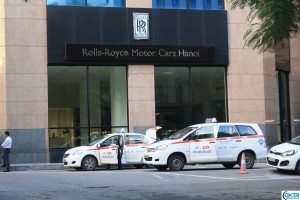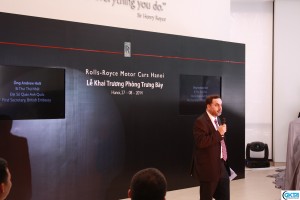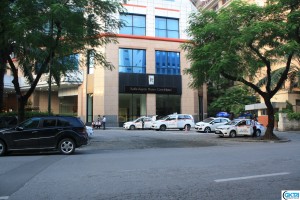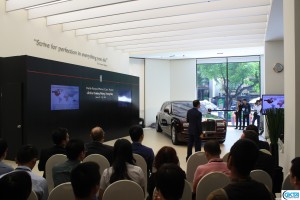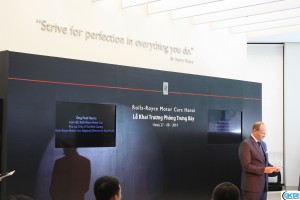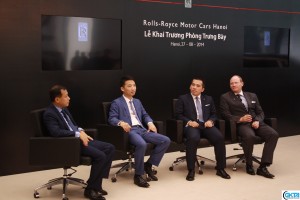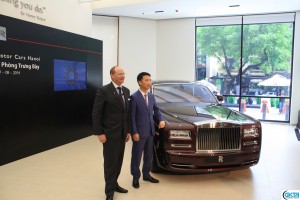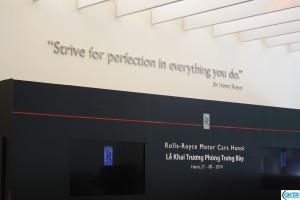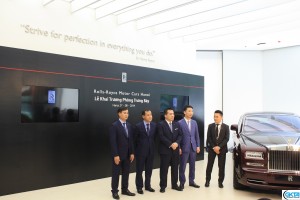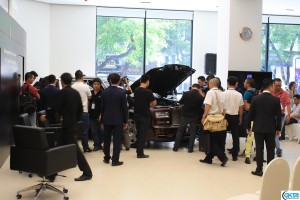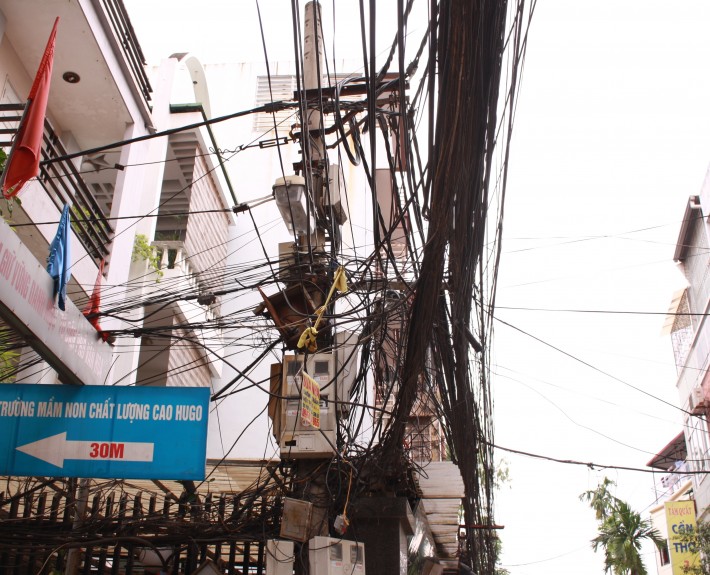The Changing Face of the Auto Market
On August 27, 2014 the first Rolls-Royce Motor Cars showroom opened up in Hanoi, the capital city of Vietnam. Two events were held at the showroom in the HCO Building at 44B Ly Thuong Kiet, next to the Melia Hotel. One event was held for members of the press from 2:00 PM to 4:00 PM and included the official ribbon-cutting ceremony. Later, from 6:00 PM to 8:00 PM, an event for VIPs and potential customers was held in private at the showroom and adjoining outdoor patio.
British First Secretary, Andrew Holt, attended the event and delivered some prepared remarks about the significance of the first Rolls-Royce Motor Cars showroom in Vietnam. Mr. Holt expressed that he was honored to be part of the Vietnam success story. In fact, the common theme throughout the press event was the “remarkable success story” of Vietnam and the “country’s ambition for the future.”
In effect, the event on Wednesday was put into motion over a year ago. In June 2013 Rolls-Royce Motor Cars announced Regal Motor Cars as its first authorized partner in Vietnam. The chairman of the authorized dealer, Rolls-Royce Motor Cars Hanoi, is Minh Doan with Trung Doan serving as the Chief Operations Officer. In the time leading up to the official showroom opening ceremony on Wednesday, the brand’s Facebook page had already accumulated over 32,000 “Likes” which, according to Mr. Holt, served as an example of how the Vietnam market was ready for an official dealership.
When directly asked about unit sales in Vietnam prior to the opening of the official dealership, Paul Harris, regional director Asia-Pacific at Rolls-Royce Motor Cars, responded that it was difficult to know exactly how many cars had been sold in Vietnam due to unofficial channels but that it was around 100 cars. Mr. Harris revealed that Rolls Royce had directly supported one car’s production from Goodwood, England, where the company’s cars are assembled by hand.
Mr. Harris reiterated that now that Vietnam has an official dealership, it is the place to go to satisfy consumer demand for the brand and Rolls-Royce Motor Cars sees the Vietnamese market growing, with great potential in the future. In terms of global demand, the Ghost is the most popular model, followed by the Wraith and the Phantom.
Finding a Suitable Vietnamese Partner
The on-boarding process for the local partner was revealed by Mr. Harris; first, potential Vietnamese partners were encouraged to apply. Rolls-Royce then assessed the candidates, and analyzed the business, the partner fit, and passion of competitive candidates. Rolls-Royce selected Mr. Minh in part because he is a Rolls-Royce owner himself and the Rolls-Royce team felt that he was in a unique position to understand the brand and to deliver the brand’s message and values to the Vietnamese market.
During the Q&A portion of the event, a member of the Vietnamese press asked Mr. Harris why Regal Motor Cars was chosen as an authorized but not exclusive dealer. Mr. Harris responded that, for Rolls-Royce Motor Cars, authorization means exclusive as it has no intention to expand to a second dealership in Vietnam. Mr. Harris wrapped up his response by explaining that Rolls-Royce Motor Cars knows that demand is here in Vietnam for significant sales and that “we and our dealer partner are happy with the sales forecast but won’t divulge numbers.”
Rolls-Royce Motor Cars, currently owned by BMW AG, is in the midst of expansion plans in the Asia-Pacific region outside of China. Last year a showroom in Osaka, Japan was opened up and a new dealer partner was announced in Manila, Philippines as well.
The “Oriental Sun” Rising in Asia
On display was an $1.8 million model, the Oriental Sun, an exclusively produced limited edition model for Vietnam. That extravagant model was sold during the second event held at the showroom at night. In many ways it’s amazing that there is even a market for such vehicles in a country where the gross national income per capita is around $2,000.
It’s not surprising that the first Rolls Royce dealership opened in Hanoi instead of Saigon. Many luxury brands pass through the capital before setting up shop in the south where the customers usually evaluate products on more criteria besides price and/or country of origin. Rolls-Royce Motor Cars would be wise to continue these custom runs of single units (in addition to its Bespoke program) so as to allow potential customers in Hanoi and the surrounding areas to further differentiate themselves from their contemporaries—especially in the northern provinces of Vietnam. After all, one measure of uniqueness is the price tag between the same or similar products.
The Vietnamese Auto Market
Rolls-Royce Motor Cars’ expectations for the Vietnam market are in line with those of other auto manufacturers. Recently, Mercedes-Benz Vietnam announced that it had sold more than 1,000 cars in the first six months of the year. These sales figures amounted to a 70% increase from the same time last year and set a new record in the company’s 19 year history in Vietnam.
In total, more than 65,000 vehicles were sold in the first six months of the year according to Vietnam Automobile Manufacturers Association. A brand new car in Vietnam can cost two-to-three times or more than a similarly equipped model in the US due to taxes and import duties. Vietnam Automobile Manufacturers Association projects that a total of 130,000 vehicles will be sold this year, compared to 110,519 in 2013.
Luxury cars are becoming more common place in cities like Hanoi and Saigon. One can spot Lamborghinis, Ferraris, Maseratis, Bentleys and the full gamut of European and Asian luxury vehicles at any time of day or night while walking in either city’s downtown. While not everyone can afford such exotics or high-end luxury vehicles, there is still much demand for and attention given to these foreign brands.
In 2013, the Vietnam Motor Show, held at the Saigon Expositions and Convention Center (SECC) in District 7, Saigon drew over 155,000 visitors over the course of four days last October and resulted in the sale of 200 cars during the event. For comparison, the New York International Auto Show (NYIAS), the oldest and biggest auto show in the US, attracts slightly more than a million people over nine days. At the Vietnam Motor Show last year, some luxury brands such as Infiniti and Lexus made their first appearances at the event. And last year more than half of all luxury sales were comprised of Mercedes Benz vehicles—a sign of the preferred auto brand by Vietnam’s elite.
For those looking to score a deal in Vietnam’s pre-owned car market there are a myriad of options available including, but not limited to:
- www.banxetot.com (literally “sell good car”)
- www.bonbanh.com (literally “four wheels”)
- www.muabanoto.vn (literally “buy-sell car”)
- www.muabanoto.net (literally “buy-sell car”)
- www.choxe.net (literally “car market”)
- www.anycar.vn
The Future of Auto (and Luxury Goods) Sales in Vietnam
As Vietnam’s economy grows, so too will grow the number of successful individuals who can afford the high price tags of luxury goods offered by established brands. These brands, of course, include luxury auto makers. In some ways, a car someone drives in Vietnam is more important than the home where s/he lives because everyone can see his/her car and few may see the inside of his/her home. This value placed on public appearances can lead to interesting situations where a high-end luxury vehicle may be parked in front of a modest looking house (or an attempt at an Asian castle).
Regardless, the number of people who will be able to afford these luxury vehicles and other goods in Vietnam will only increase. Auto and other luxury goods makers will need to find new ways for the nouveau riche and super rich to distinguish themselves from the hoi polloi. At the same time, the newest rich joining the ranks of the newly rich also leaves the door open for after market modifications from esteemed companies such as Brabus. Then, the only question left to answer will be where to drive such a super-charged beast? For sure not in rush hour traffic in either Hanoi or Saigon.
Still, the Vietnamese dream is to drive to work in a car. It serves as one measure that s/he has “made it” and it also helps to insulate from bad weather, pollution, and nasty injuries resulting from traffic accidents since cars are higher in the pecking order than motorbikes and other two-wheeled modes of transport.
The takeaway here should be that if rich Vietnamese can afford luxury vehicles with high sticker prices then they can probably afford whatever luxury brand you represent (and they will most likely want to buy it). The key is to set the new standard for whatever experience you are trying to create—because once you do that then most consumers and other brands will follow. Getting that first domino to tip may be tricky but the rewards will surely make it worth your while to make it happen.

